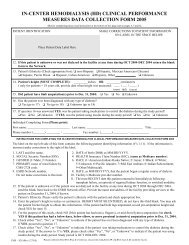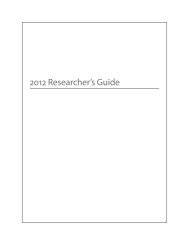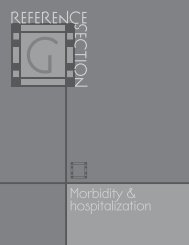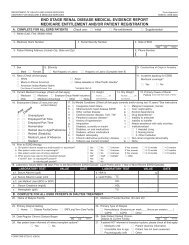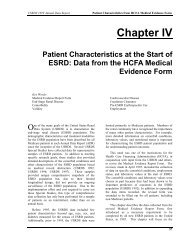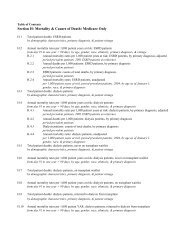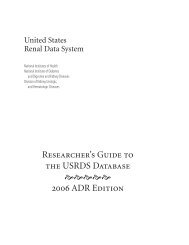2009 ADR v2 Atlas of ESRD - United States Renal Data System
2009 ADR v2 Atlas of ESRD - United States Renal Data System
2009 ADR v2 Atlas of ESRD - United States Renal Data System
You also want an ePaper? Increase the reach of your titles
YUMPU automatically turns print PDFs into web optimized ePapers that Google loves.
5<br />
App A<br />
pg 374<br />
as reported on the OPTN Immunosuppression Treatment form. All<br />
such medications (apart from induction antibodies) are indicated as<br />
maintenance immunosuppression on the form. Figure 7.31 highlights<br />
the switch over time from azathioprine to mycophenolate m<strong>of</strong>ietil<br />
or mycophenolate sodium as the common anti-metabolite. Figure<br />
7.32 contrasts the percent <strong>of</strong> patients using mTOR inhibitors — sirolimus<br />
or everolimus — at baseline and one year after transplant.<br />
Figure 7.33 contrasts the percent <strong>of</strong> patients using steroids at baseline<br />
and one year after transplant. Figure 7.34 shows changes in<br />
trends <strong>of</strong> antibody induction use over time, and Figure 7.35 shows<br />
the most common immunosuppression regimes in adult patients<br />
transplanted during 2005–2007.<br />
GRAFT SURVIVAL<br />
Figure 7.36 shows the percentage <strong>of</strong> adult transplants with primary<br />
non-function, defined as kidney failure within seven days <strong>of</strong> transplantation,<br />
while Figure 7.37 illustrates the distribution <strong>of</strong> eGFR one<br />
year after transplant. Figure 7.38 shows five-year graft survival by<br />
eGFR for patients transplanted in 2000–2005, with graft function at<br />
one year post-transplant. Graft survival rates are estimated using<br />
the Kaplan-Meier method.<br />
Figures 7.39–40 present five- and ten-year graft survival, as well as<br />
conditional half-lives, for adult recipients <strong>of</strong> kidneys from deceased<br />
and living donors. All estimates are made from Cox proportional<br />
hazards models, adjusted for transplant year, age, gender, race, and<br />
primary diagnosis, and based on the population’s average survival<br />
curves, rather than on curves <strong>of</strong> the average patient in the population.<br />
Estimates <strong>of</strong> conditional half-lives are conditional on first-year<br />
graft survival, and estimated from the cumulative hazard between<br />
years one and two. Conditional half-lives are interpreted as the estimated<br />
median survival <strong>of</strong> grafts surviving the first year, while halflives<br />
are interpreted as the estimated median survival <strong>of</strong> all grafts.<br />
Figure 7.41 presents one-year post-transplant hospital admission<br />
rates for Medicare patients receiving their first kidney-alone transplant<br />
in 2006. <strong>Data</strong> are collected from Medicare claims occurring<br />
within a year <strong>of</strong> discharge from the transplant hospitalization, and<br />
exclude the transplant hospitalization. Admission rates are censored<br />
at graft failure, loss <strong>of</strong> Medicare coverage, or December 31, 2007.<br />
Statistical methods for computing admission rates are similar to<br />
those described for Reference Section G, but cohorts are constructed<br />
differently. Instead <strong>of</strong> computing rates in point prevalent patients<br />
within a given year, we define the cohort based on transplant year<br />
and examine hospital claims up to a year post-transplant. Figure<br />
7.42 shows the primary cause <strong>of</strong> hospitalization for cardiovascular<br />
problems or infection up to three years post-transplant in Medicare<br />
patients who had their first kidney-alone transplant in 2003–2005.<br />
Figure 7.43 presents the one-year cumulative incidence <strong>of</strong> acute<br />
rejections in adult, first-time, kidney-alone transplant patients discharged<br />
from the transplant hospitalization with a functioning graft.<br />
A patient is assumed to have acute rejection if OPTN data collection<br />
forms note 1) acute rejection episodes, 2) that medications were given<br />
for acute rejection, and that 3) acute rejection was the primary or<br />
secondary cause <strong>of</strong> graft failure. B3iopsy-proven status was available<br />
starting in 1991 on the OPTN Transplant Recipient Registration,<br />
which identifies early rejection, but was not added to the Transplant<br />
Recipient Follow-up form until April, 2003. Rejections that<br />
are a primary or contributing cause <strong>of</strong> graft failure are assumed<br />
to be biopsy-proven, while rejections identified by treatment status<br />
are not assumed to be biopsy-proven. Cumulative incidence is<br />
estimated using Kaplan-Meier methods, censored at death or one<br />
year post-transplant.<br />
Figures 7.44–45 present data on post-transplant diabetes and<br />
post-transplant lymphoproliferative disorder (PTLD). The patient<br />
population includes first-time, kidney-only recipients, 2000–2004,<br />
with Medicare as primary payor. To identify de novo post-transplant<br />
diabetes, patients are further required to have six months<br />
<strong>of</strong> Medicare primary payor coverage prior to transplantation. We<br />
search for claims during this entry period indicating diabetes, and<br />
patients with these claims are omitted. To identify PTLD, we search<br />
Medicare claims for ICD-9-CM diagnosis codes 200.xx, 202.xx, and<br />
204.xx. Only the first three years post-transplant are searched for<br />
each condition, as many transplant recipients lose Medicare coverage<br />
three years post-transplant. For each complication, the figure<br />
shows cumulative incidence over the three-year post-transplant<br />
period; this incidence is estimated from a Cox proportional hazards<br />
model, adjusting for age, gender, race, Hispanic ethnicity, primary<br />
cause <strong>of</strong> renal failure, year <strong>of</strong> transplantation, donor type, hepatitis B<br />
and C serology, education level, employment status, time on dialysis,<br />
donor age, donor gender, donor race, HLA mismatches, recipientdonor<br />
body surface area matching, body mass index, panel reactive<br />
antibodies, cytomegalovirus matching, baseline maintenance<br />
immunosuppression (cyclosporin, neoral, tacrolimus, rapamycin,<br />
azathioprine, mycophenolate m<strong>of</strong>etil), and anti-lymphocyte receptor<br />
antibody use (IL-2, other), and estimated from the population<br />
average curve rather than the curve <strong>of</strong> the average patient. In Figure<br />
7.45, we overlay PTLD data from OPTN sources in the Medicare<br />
population and in all transplant patient.<br />
In Figure 7.46 we present the rate <strong>of</strong> return to dialysis/preemptive<br />
retransplantation, the rate <strong>of</strong> death with a functioning graft,<br />
and the rate <strong>of</strong> any graft failure, which includes failure due to death.<br />
Rates are limited to adult patients, and estimated from a Poisson<br />
regression, adjusting for age, gender, and race.<br />
Figure 7.47 displays causes <strong>of</strong> death for adult patients transplanted<br />
between 2003 and 2007 who subsequently die with a functioning<br />
graft. Causes <strong>of</strong> death are ascertained from OPTN transplant followup<br />
data, or, if unknown, from the <strong>ESRD</strong> Death Notification form.<br />
Figure 7.48 presents data on graft failures in adults that necessitate<br />
long-term dialysis; graft failures due to death and preemptive<br />
retransplantation are excluded from these counts. Subsequent<br />
treatment is determined from a combination <strong>of</strong> Medicare claims<br />
and OPTN data.<br />
Figure 7.49 shows the proportion <strong>of</strong> adult patients who go back<br />
on the wait list or receive a subsequent transplant within a year <strong>of</strong><br />
graft failure, while Figure 7.50 shows the median and 25th percentile<br />
for months to retransplantation, and Figure 7.51 shows modality<br />
immediately following graft failure. The y-axis for Figures 7.49–51 is<br />
the year <strong>of</strong> graft failure. Kaplan-Meier methods are used to compute<br />
rates and time to re-transplantation, with censoring at death with<br />
a functioning kidney. In Figure 7.50, the Kaplan-Meier median is<br />
not observed for patients whose grafts failed after 1999.<br />
REFERENCE SECTION E<br />
Tables E.1–6 present measures regarding the wait list for renal transplantation.<br />
Wait list data prior to 1988 are not shown; the OPTN wait<br />
list began in earnest in 1987. Table E.1 presents counts <strong>of</strong> patients<br />
newly added to the wait list for a kidney or kidney-pancreas transplant<br />
on December 31 <strong>of</strong> the given year. Patients listed at multiple<br />
transplant centers are counted only once. Table E.2 presents wait<br />
times, defined as the median time in days from first listing to transplant<br />
among patients listed for a kidney-alone transplant. Kaplan-<br />
Meier methodology is used to estimate median wait times. Table<br />
E.3 presents counts <strong>of</strong> patients on the wait list on December 31 <strong>of</strong>




